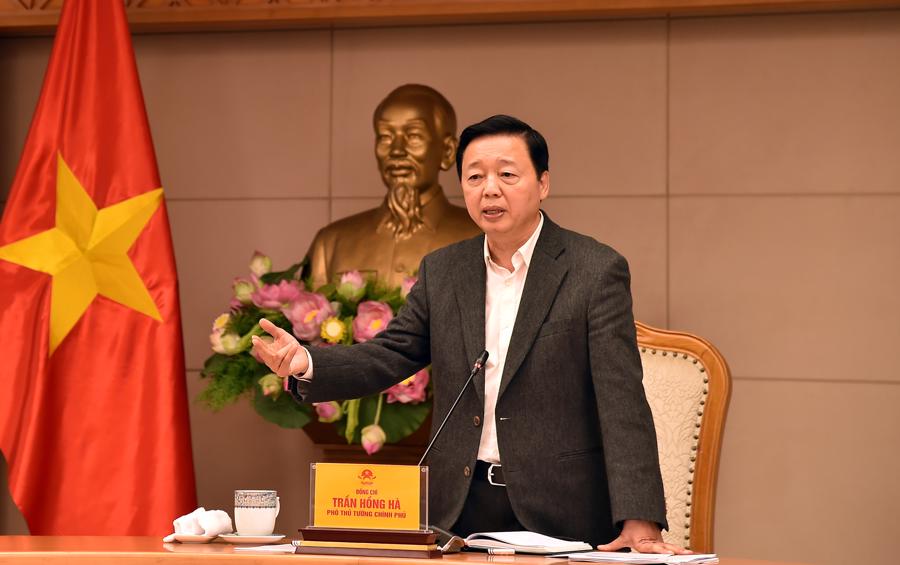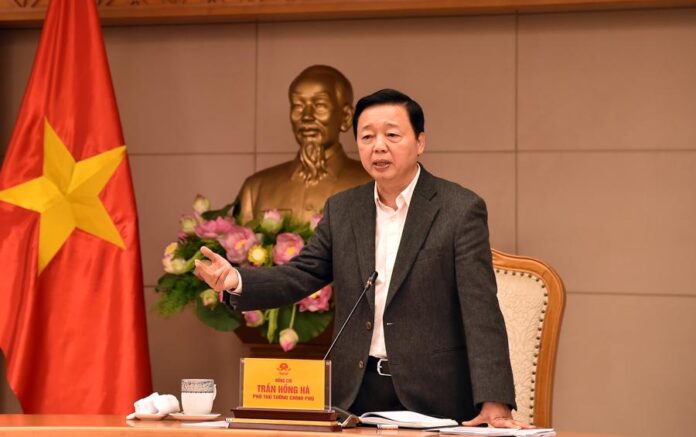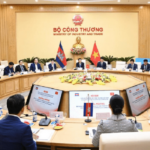On February 4th afternoon, Deputy Prime Minister Tran Hong Ha chaired a meeting to review and provide feedback on the draft Decree defining the functions, tasks, and organizational structure of the Ministry of Agriculture and Environment (the new ministry formed by the merger of the Ministry of Natural Resources and Environment and the Ministry of Agriculture and Rural Development).
According to the report by the Ministry of Natural Resources and Environment, the drafting process has been conducted urgently and seriously, ensuring compliance with the constitution and the law, as well as consistency in the system of legal documents.
The Ministry of Agriculture and Environment is a diverse and multifaceted ministry, ensuring seamless operation and smooth functioning post-merger, with no legal gaps. The structure is designed to align with the Central Steering Committee’s and the Government’s Steering Committee’s directions on implementing Resolution No. 18-NQ/TW, fitting the country’s context and future demands. It strikes a balance between continuity and innovation, ensuring comprehensiveness and consistency in the state administration system.

The ministry will continue to focus on macro-management, decentralization, and empowerment, along with strengthened inspection, supervision, and control of power in implementing policies and laws under its management domain.
The Ministry of Agriculture and Environment will undertake the state management functions currently assigned to the Ministry of Natural Resources and Environment and the Ministry of Agriculture and Rural Development. Specifically, the ministry will manage: Agriculture; forestry; salt production; fisheries; irrigation; disaster prevention; rural development; land; water resources; geology and minerals; environment; hydrometeorology; climate change; surveying and mapping; remote sensing; integrated management of marine and island resources and environment; and public services in these domains.
The organizational structure will be rearranged, consolidating 26 units from the Ministry of Natural Resources and Environment and 27 units from the Ministry of Agriculture and Rural Development into 30 units.
Deputy Minister of Justice Dang Hoang Oanh acknowledged that this ministry has undergone one of the most significant streamlining processes in terms of reducing management layers.
In his directive, Deputy Prime Minister Tran Hong Ha emphasized that the draft Decree should not merely mechanically combine the contents of the two existing decrees defining the functions and tasks of the respective ministries. Instead, it should incorporate updates and supplements regarding new legal provisions and management ideas related to land, resources, the environment, and agriculture.
The Deputy Prime Minister reiterated the principle of “not assigning one task to two persons” and requested the Ministry of Natural Resources and Environment to coordinate with the Ministry of Justice, the Ministry of Home Affairs, and the Government Office to review and ensure that there is no overlap or gap in the functions assigned by law to the new ministry.
“The Ministry of Agriculture and Environment must define clear tasks and functions to meet practical demands in promoting a green transition, prioritizing environmental protection over economic and social activities, and achieving sustainable and multi-objective agricultural transformation while ensuring food security,” emphasized the Deputy Prime Minister.
The organizational structure of the Ministry of Agriculture and Environment should be based on a review of assigned functions and tasks and should address overlaps and redundancies in state management between ministries, between central and local authorities, and between state management agencies and public service units and enterprises.
The Deputy Prime Minister also noted the urgency of developing criteria, positions, and job descriptions suitable for the work of each bureau and department.
Additionally, the Deputy Prime Minister provided feedback on proposals regarding the transitional operations of some public service units no longer under the Ministry of Agriculture and Environment, the financial and income mechanism for specific areas (veterinary, livestock breeding, crop cultivation, plant protection, and management of agricultural, forestry, and aquatic product quality), and the reception of poverty reduction tasks from the Ministry of Labour, Invalids and Social Affairs.
The Deputy Prime Minister requested the leaders of the Ministry of Natural Resources and Environment and the Ministry of Agriculture and Rural Development to finalize the draft Decree for submission to the Government. It is expected to take effect immediately after the National Assembly passes a resolution establishing the Ministry of Agriculture and Environment.
“Vietnam and Cambodia Unite to Boost Bilateral Trade to $20 Billion”
The two ministers, Nguyen Hong Dien and Cham Nimul, emphasized the significance of economic and trade cooperation, deeming it a pivotal aspect of strengthening ties between Vietnam and Cambodia. They agreed to set an ambitious target of increasing bilateral trade to 20 billion USD in the coming years.
The Vietnamese Steel Market in Q1 2025: A Tale of Domestic Revival and Export Standstill
The domestic steel industry witnessed robust growth in the first quarter of 2025, with production and consumption on the rise, fueled by an economic rebound and robust public investment disbursements. However, steel exports faced significant headwinds due to international trade barriers, plunging into a deep decline and presenting fresh challenges for steel companies.





















